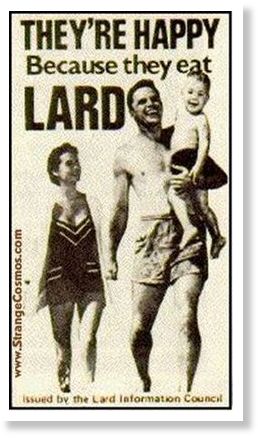
© Strangecosmos.com
In a recent article I wrote on my other blog,
9 Steps to Perfect Health - #1: Nourish Your Body, I explained that saturated (SFA) and monounsaturated fats (MFA) are the preferred fuel source of the body. Another important benefit of LCSFA, and to a lesser degree MFA, is that they are stable at high temperatures and thus the safest fats to cook with.
With this in mind, here's a list of my favorite cooking fats. Not just because they're safe to cook with, but because they taste so good.
GheeGhee is clarified butter, and it's popular in Indian cooking. Because the milk solids have been removed, it's very low in lactose and is almost entirely fat - mostly saturated. I tend to use ghee to brown meat and sautee garlic and onions when I make soups or stews, and I sometimes scramble my eggs in it. A tablespoon of ghee contains 8g SFA, 3.7g MFA fat and 0.5g PUFA.
Coconut oilAlong with ghee, coconut oil is one of the best fats to cook with because it's almost entirely saturated. In fact, coconut oil is more than 90% saturated fat. While this makes it the devil according to the so-called medical authorities, we know better. In addition to being a great fuel source for the body, coconut oil has some unique properties. It is a special type of saturated fat called medium chain triglyceride (MCT). Unlike other fats, MCTs do not require bile acids for digestion. This means they are easily absorbed in the upper part of the small intestine. Coconut oil is also rich in lauric acid, a fatty acid found in mother's milk that is anti-fungal, anti-bacterial and anti-viral. Coconut oil has 4g of SFA, 0.3g of MFA and <0.1g of PUFA.
Leaf lardNo self-respecting French chef would ever be without lard. Leaf lard is obtained from the visceral fat deposit surrounding the kidney and loin, and is considered the highest grade of lard because it has little pork flavor. This is why it's prized in baking, where it's used to make flaky, moist pie crusts, croissants and other non-Paleo delights. Lard is an incredibly versatile fat. I use mostly to roast vegetables. Unlike olive oil, vegetables roasted in lard do not get soggy or greasy. They stay crisp and almost dry, with a wonderful flavor. This surprises people because they think of lard as "greasy". Not so. A tablespoon of lard has about 6g MFA, 5g SFA and 1.6g PUFA.
Duck fatLet me just say this, if you've never had potatoes roasted or fried in duck fat, you haven't had French fries. I mean that literally. Duck fat was what folks in Europe used to make the original French fries before industrial seed oils came along. Once you taste potatoes - or any vegetables - roasted or fried in duck fat, you'll know why. A tablespoon of duck fat has 6 g MFA, 4 g LCSFA and 1.6 g PUFA.
ButterButter has a lower smoke point than the fats listed above, which makes it less suitable for high temperature cooking. However, it's a great fat to use on top of fish or meat in the oven, or in stews or slow-cooked meals at lower temperatures. "Butter makes everything better" is exactly right. A tablespoon of butter contains 7.2g of SFA, 2.9g of MFA and 0.4g of PUFA.
Given all the lies we were told, I sadly ask self how did America ever even last as long as it did? I'd guess the answer to be that the momentum of our parents and ancestors' truths, in us and ours, got America that far.
However, that momentum of innate and environmental truth-seeking, by American individuals and institutions, has been effectively stopped by the PTB/MSM's lies to the current and pacified, drugged, flouridated, and intentionally-dumbed-down* AmeriKa.
Everything's a lie,
We're stuck in a moving box.
(James Jones and S. Crane.)
R.C.
*(pardon the mega-redundancies)